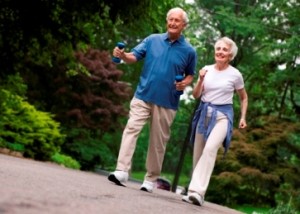Exercise and Bone Health. Oftentimes, my patients ask me the question: How does exercise improve my overall bone health? Frequently, they are familiar with the benefits of exercise, in terms of reducing the risk for heart disease and stroke, and preventing obesity. However, not as well understood is the importance of exercise and bone health, using regular physical activity in building and maintaining healthy bones.
 As we age our bones become weaker and more fragile, a condition called osteoporosis. It occurs more often in women after menopause, but also affects men in older age. This bone-thinning disease puts people at a greater risk for broken bones, which can seriously limit mobility and independence. This is especially true in Maine which ranks first in the United States with an oldest mean age of the population. I see the end result of osteoporosis combined with falls resulting in broken bones first hand when I take orthopedic trauma call at Maine Medical Center.
As we age our bones become weaker and more fragile, a condition called osteoporosis. It occurs more often in women after menopause, but also affects men in older age. This bone-thinning disease puts people at a greater risk for broken bones, which can seriously limit mobility and independence. This is especially true in Maine which ranks first in the United States with an oldest mean age of the population. I see the end result of osteoporosis combined with falls resulting in broken bones first hand when I take orthopedic trauma call at Maine Medical Center.
Exercise and bone health are closely linked. Exercise is essential for maintaining bone strength as we grow older. It works on bones in a similar fashion as it works on muscles. It makes them stronger. Bone is a living tissue, it responds to stresses placed on it. When you exercise, the stress placed on bones trigger cells to build stronger bones and make them more dense. An additional benefit of exercise is that it improves balance and coordination. This is especially important for older individuals because it helps to prevent falls, the leading cause of hip fractures and other bony fractures.
Exercise and Bone Health: Specific Exercises for Stronger Bones
Lots of exercises exist, each one offering different health benefits. The two types of exercise most effective for building strong bones are weightbearing exercise and strength-training exercise.
Weightbearing exercise involves activities performed on your feet that work your bones and muscles against gravity. The added stress of carrying body weight increases the amount of stress placed on bones, making them stronger. I encourage my patients to participate in weightbearing exercises like brisk walking, hiking, dancing, tennis, and stair climbing.
Strength-training activities involve adding resistance to movement in order to make muscles work harder. Specific ones that I recommend include using weight machines and working with free weights. In addition to increasing muscle mass, these exercises also put stress on bones which in turn increases bone-building capacity.
Additional Forms of Exercise for Bone Health
While the above mentioned exercises help to strengthen bone, I recommend non-impact exercises, such as yoga or tai chi, to improve flexibility and balance training to assist with fall prevention. For my patients that have underlying arthritis, non-weightbearing exercise such as swimming and cycling are excellent choices to strengthen their heart and lungs.
Exercise and Bone health: A Program for Bone Health Fitness
An exercise program I recommend for my patients to improve bone health includes 30 minutes of weightbearing activity, 4 or more days a week. Staying motivated is important, so I recommend choosing an activity that you enjoy. A 10-minute brisk walk three times a day is a great way to get started.
To gain the most from exercise, it is important to add flexibility and balance training to the mix. Make sure all exercise sessions end with stretching which improves your ability to move easily and can reduce your risk for injury.
Conclusion
Exercise has been shown to have bone-building effects. However, it is just one element of a total program to prevent bone loss. Understanding your individual risk for osteoporosis, such as genetic factors and family history, is essential. A balanced, calcium-rich diet and a healthy lifestyle are also key ingredients for lifelong bone health.
Exercise and Bone Health comes to us from Adam J. Rana, MD, Attending Orthopedic Surgeon at Maine Medical Partners Division of Joint Replacements and Assistant Clinical Professor at Tufts School of Medicine.